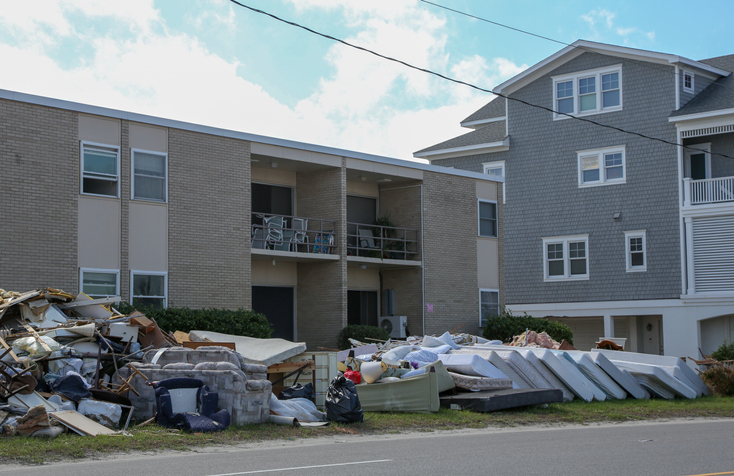Hurricane Florence ripped through the Carolinas in September, followed shortly thereafter by Hurricane Michael in Florida. Both caused substantial devastation, in different ways.
Shortly after each hurricane passed, we at GLE had teams on the ground helping to mitigate the storm damage and get property owners back into their properties as quickly as possible. Now that our folks are back from their work in NC, we wanted to give you a ground-level view of recovery efforts in the Carolinas.
Wind-Blown Water on the Carolina Coast
Edisto Island is a small island on the coast of South Carolina. Its famous beach is a popular vacation destination, with a number of upscale resorts.
Because of its unprotected exposure to the Atlantic Ocean, it was originally predicted that Edisto would suffer substantial damage from Hurricane Florence. Luckily for residents and property owners there, the hurricane went north, preventing some of the worst ravages of the storm from affecting them.
Nevertheless, many buildings were impacted by wind-blown water. Our teams were called in as soon as the area was accessible to provide moisture mapping for a large resort property containing about 400 units.
In the aftermath of water damage, time is of the essence. You have about 48 hours to get the building completely dry, before mold sets in. Once mold sets in, mitigation becomes much more complicated and expensive.
“Most of the damage in these units was on the first two floors,” says Victoria Basham, a Project Manager with GLE who was deployed to Edisto right after the storm. “It came in from sliding glass doors and windows, roof damage, and other openings in the building envelope.”
GLE’s moisture mapping process was critical in making sure that the damage was assessed quickly so that remediation contractors could move in and mitigate fast. We obtained as-built drawings from the property owner in advance, and equipped our team with mobile devices with access to the drawings. Our people were able to move through all 400 units efficiently, marking the drawings with locations of moisture damage, so that contractors could get in and get set up immediately.
Flooding in Wilmington
The fact that the storm moved north benefited some areas, while causing more devastation in others. The beach town of Wilmington, South Carolina, was one of the hardest hit areas. The eye of Hurricane Florence passed directly over the area, spawning tornadoes as it went, and causing massive storm surges and flooding.
According to a Wilmington news source, the storm caused 37 deaths, 350 water rescues, displaced more than 1200 people, and did approximately $220 million worth of property damage (initial estimates). Storm surges reached as high as 5 feet, and flooding continued for many days after the storm passed, thanks to water flowing from upstream and subsequent levee and dam breaks.
Unlike Edisto, most of the damage in Wilmington was caused by flood waters, which requires a different type of mitigation than wind-blown water. Wind-blown water tends to be relatively clean and non-toxic, and often only requires drying out. Flood waters, on the other hand, usually contain a wide range of contaminants, including toxic waste, animal bodies, sewage from broken lines, and more.
As a result, flood damage usually requires that affected materials be removed and replaced. Unfortunately, this can mean that toxic substances, such as asbestos, can be disturbed and released into the environment. To prevent this, our teams went into Wilmington to perform asbestos bulk sampling for our clients so that they could engage in appropriate mitigation efforts.
Again, time is of the essence in mitigation efforts. The longer that flood water contaminated materials stay in place, the worse the damage becomes. We moved our teams into Wilmington as soon as the area was open, and used our mobile mapping technology to direct the effort to obtain building material samples. We then couriered the samples to the nearest lab to get 3-hour results, allowing contractors to begin work almost immediately.
Coordinating It All
Responding to a disaster means managing a lot of chaos. Many roads into Wilmington, for instance, were closed for several days after the storm. Some roads would come open while others would close suddenly due to levees breaking.
For response teams, the calls for help can be overwhelming if they’re not well prepared and coordinated. We begin our coordination efforts before a storm hits, contacting all of our clients in the affected areas in advance, and making sure we have all the information we need to respond to them quickly if they need it.
For each storm response effort, we assign a central contact person in our main office to coordinate.
“All of our offices get calls for manpower after a storm,” says Jim Elliott, North Florida Operations Manager for GLE. “So we need one person who understands the number of people mobilized, the transportation needs, and the geography of response efforts, to make sure everything gets taken care of in a timely and coordinated fashion.”
Of course, even with advanced preparation and plenty of support, a direct hit from a hurricane is traumatic for residents and property owners.
“When I was in Wilmington, the residents were eager to tell me their horror stories,” says Basham. “They showed me pictures, and it looked like a bomb had gone off in some areas.”
Yet there’s a lot of hope for the Hurricane Florence recovery efforts in the Carolinas, too.
“The communities there were busy having meetings to coordinate recovery efforts,” says Basham. “Everyone was helping each other out.”
We’re honored to have been a part of the Hurricane Florence recovery effort for the Carolinas, and wish them well in continuing efforts. Our teams, having done what we were called to the Carolinas for, are now busy responding to damage from Hurricane Michael. Stay tuned for an update on those efforts soon.






